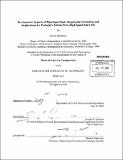| dc.contributor.advisor | Joseph M. Sussman. | en_US |
| dc.contributor.author | Melibaeva, Sevara (Sevara Mukhtarovna) | en_US |
| dc.contributor.other | Massachusetts Institute of Technology. Dept. of Civil and Environmental Engineering. | en_US |
| dc.coverage.spatial | e-po--- | en_US |
| dc.date.accessioned | 2011-01-26T14:27:51Z | |
| dc.date.available | 2011-01-26T14:27:51Z | |
| dc.date.copyright | 2010 | en_US |
| dc.date.issued | 2010 | en_US |
| dc.identifier.uri | http://hdl.handle.net/1721.1/60807 | |
| dc.description | Thesis (S.M. in Transportation)--Massachusetts Institute of Technology, Dept. of Civil and Environmental Engineering, 2010. | en_US |
| dc.description | Cataloged from PDF version of thesis. | en_US |
| dc.description | Includes bibliographical references (p. 195-203). | en_US |
| dc.description.abstract | High-speed rail (HSR) has been gaining acceptance worldwide with development of rail technology and rising concerns over climate change and congestion in airports and on roads. The implementation of high-speed rail lines also plays an important role in reshaping the travel patterns and activities of people and consequently change the ways cities develop. An interesting indirect implication of HSR is the potential for megalopolis formation created by fusion of multiple cities linked by HSR. An overall consensus is present in the existing theoretical literature as to what development impacts may be from the HSR investment, including the importance of the resulting agglomeration externalities and formation of megalopolises. However, the complexity of the issue leaves the questions about the causal effect of HSR on economic growth open. This thesis studies the existing empirical evidence and experiences of HSR corridors in Japan, France and Germany to explore qualitatively the phenomenon of "megalopolis" formation as a result of a HSR link, and the evidence of economic development effects on urban areas along these corridors. Portugal among other countries is also planning the deployment of a HSR network in the near future as an effort to stimulate the country's economy and to integrate with the rest of the European Union. The findings and lessons from the case studies are applied to Portugal's proposed Lisbon-Porto HSR corridor. Several possibilities of future scenarios of megalopolis forms and the associated impacts are discussed and analyzed. As a result of improved accessibility and increased interaction between the cities stimulated by HSR, emergence of a megalopolis is possible in different forms along the planned Lisbon-Porto HSR corridor. The critical factor for the formation of a megalopolis is the increased interaction between the cities driven by newly generated traffic and increase in the number of one-day trips. These new travel patterns within a megalopolis may lead to either creation of new economic growth or redistribution of economic activity. The spatial distribution of growth is non-uniform, which may essentially lead to potential winners and losers from HSR. This research is intended to be of value to policy-makers in the railway industry. | en_US |
| dc.description.statementofresponsibility | by Sevara Melibaeva. | en_US |
| dc.format.extent | 207 p. | en_US |
| dc.language.iso | eng | en_US |
| dc.publisher | Massachusetts Institute of Technology | en_US |
| dc.rights | M.I.T. theses are protected by
copyright. They may be viewed from this source for any purpose, but
reproduction or distribution in any format is prohibited without written
permission. See provided URL for inquiries about permission. | en_US |
| dc.rights.uri | http://dspace.mit.edu/handle/1721.1/7582 | en_US |
| dc.subject | Civil and Environmental Engineering. | en_US |
| dc.title | Development Impacts of high-speed rail : megalopolis formation and implications for Portugal's Lisbon-Porto High-Speed Rail Link | en_US |
| dc.title.alternative | Development Impacts of HSR : megalopolis formation and implications for Portugal's Lisbon-Porto High-Speed Rail Link | en_US |
| dc.title.alternative | Megalopolis formation and implications for Portugal's Lisbon-Porto High-Speed Rail Link | en_US |
| dc.type | Thesis | en_US |
| dc.description.degree | S.M.in Transportation | en_US |
| dc.contributor.department | Massachusetts Institute of Technology. Department of Civil and Environmental Engineering | |
| dc.identifier.oclc | 696008170 | en_US |
